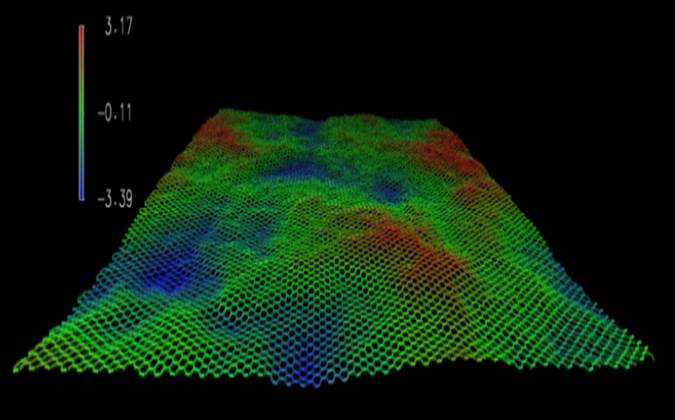Research Objectives
The primary objectives of this project are: (1) Develop experimental techniques for characterizing the adhesive interactions between graphene and supporting substrates at the nano and meso scales; (2) Develop physics-based, experimentally calibrated theoretical models and numerical simulations of graphene interacting with surrounding materials; (3) Explore new mechanistic approaches to mechanistically produce large-area graphene films.
Principal Investigators
Kenneth M. Liechti, Rui Huang, Rodney S. Ruoff
Highlights

Thermal rippling of graphene
Thermomechanical properties of monolayer graphene with thermal rippling are studied by both statistical mechanics analysis and molecular dynamics (MD) simulations. The amplitude of thermal rippling is found to depend on the membrane size by a power law with different exponents under zero stress and zero strain conditions. Such thermal rippling is responsible for the effectively negative in-plane thermal expansion of graphene at relatively low temperatures, while a transition to positive thermal expansion is predicted as the anharmonic interactions suppress the rippling effect at high temperatures. Moreover, subject to equi-biaxial tension, the in-plane stress-strain relation of graphene becomes nonlinear even at infinitesimal strain, and the tangent biaxial modulus of graphene depends on strain non-monotonically and decreases with increasing temperature.

A blister test for interfacial adhesion of graphene
Chemical vapor deposition (CVD) grown graphene had been transferred to a highly polished copper substrate from its seed foil. The graphene/photoresist composite film was pressurized with deionized water through a nominally 1-mm hole in the copper and the deflection of the membrane was measured by a full field interference method. The deflection profiles compared well with those obtained from a linear plate model that accounted for the initial strain in the membrane and a relaxed boundary condition at the edge of the blister. This was used to calculate the energy release rate as a function of delamination growth to obtain fracture resistance curves for the graphene/copper interface. The measured adhesion energy for the graphene/copper interface was higher than that of a photoresist/copper interface, but slightly lower than previous measurements for as-grown graphene on copper foil.
Selected Publications
- W. Gao and R. Huang, Thermomechanics of monolayer graphene: rippling, thermal expansion and elasticity. Submitted, September 2013.
- Z. Cao, P. Wang, W. Gao, L. Tao, J.W. Suk, R.S. Ruoff, D. Akinwande, R. Huang, K.M. Liechti, A blister test for interfacial adhesion of large-scale transferred graphene. Carbon 69, 390-400 (2014). DOI: 10.1016/j.carbon.2013.12.041.
- T. Jiang, R. Huang, Y. Zhu, Interfacial Sliding and Buckling of Monolayer Graphene on a Stretchable Substrate. Advanced Functional Materials 24, 396-402 (2014). DOI: DOI: 10.1002/adfm.201301999.
- P. Wang, W. Gao, Z. Cao, K.M. Liechti, R. Huang, Numerical analysis of circular graphene bubbles. J. Applied Mechanics 80, 040905 (2013). doi:10.1115/1.4024169.
- K. Yue, W. Gao, R. Huang, K.M. Liechti, Analytical methods for the mechanics of graphene bubbles. J. Appl. Phys. 112, 083512 (2012).
- W. Gao and R. Huang, Effect of surface roughness on adhesion of graphene membranes. J. Phys. D: Appl. Phys. 44, 452001 (2011).
- R. Huang, Graphene: Show of adhesive strength (news and views). Nature Nanotechnology 6, 537-538 (2011).
- Q. Lu, W. Gao and R. Huang, Atomistic simulation and continuum modeling of graphene nanoribbons under uniaxial tension. Modelling and Simulation in Materials Science and Engineering 19, 054006 (2011). Posted online at arXiv:1007.3298.
- Z.H. Aitken and R. Huang, Effects of mismatch strain and substrate surface corrugation on morphology of supported monolayer graphene. J. Appl. Phys. 107, 123531 (2010). Posted online at arXiv:1003.0853.
- J.H. Seol, I. Jo, A.L. Moore, L. Lindsay, Z.H. Aitken, M.T. Pettes, X. Li, Z. Yao, R. Huang, D. Broido, N. Mingo, R.S. Ruoff, and L. Shi, Two-dimensional phonon transport in supported graphene. Science 328, 213-216 (2010). DOI: 10.1126/science.1184014.
- Q. Lu and R. Huang, Excess energy and deformation along free edges of graphene nanoribbons. Physical Review B 81, 155410 (2010). Preprint posted online at arXiv:0910.0912, October 2009.
- Q. Lu and R. Huang, Nonlinear mechanics of single-atomic-layer graphene sheets. Int. J. Applied Mechanics 1, 443-467 (2009).
- Q. Lu, M. Arroyo, R. Huang, Elastic bending modulus of monolayer graphene. J. Phys. D: Appl. Phys. 42, 102002 (2009). Posted online at arXiv:0901.4370v1.
- J. Zhou and R. Huang, Internal lattice relaxation of single-layer graphene under in-plane deformation. Journal of the Mechanics and Physics of Solids 56, 1609-1623 (2008).
